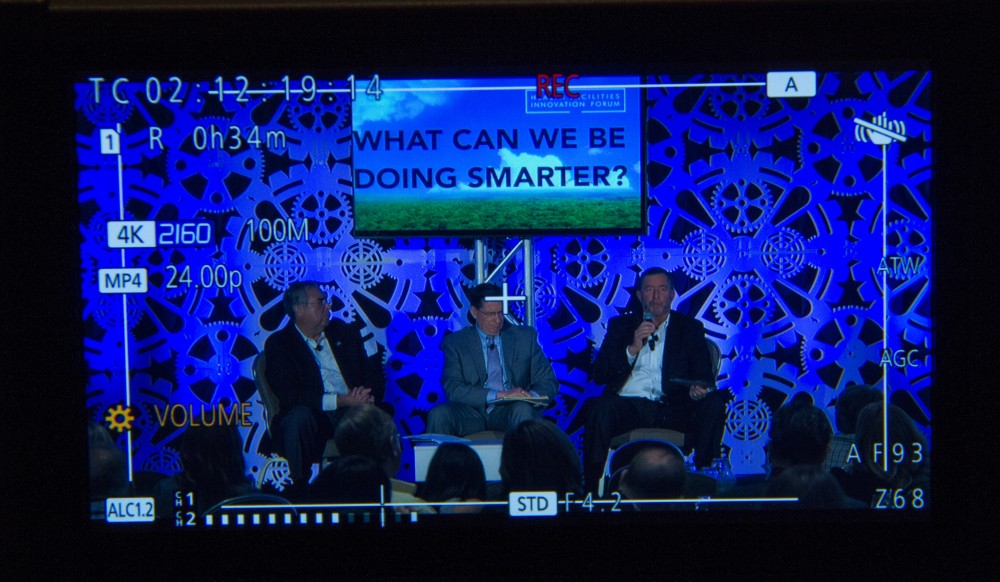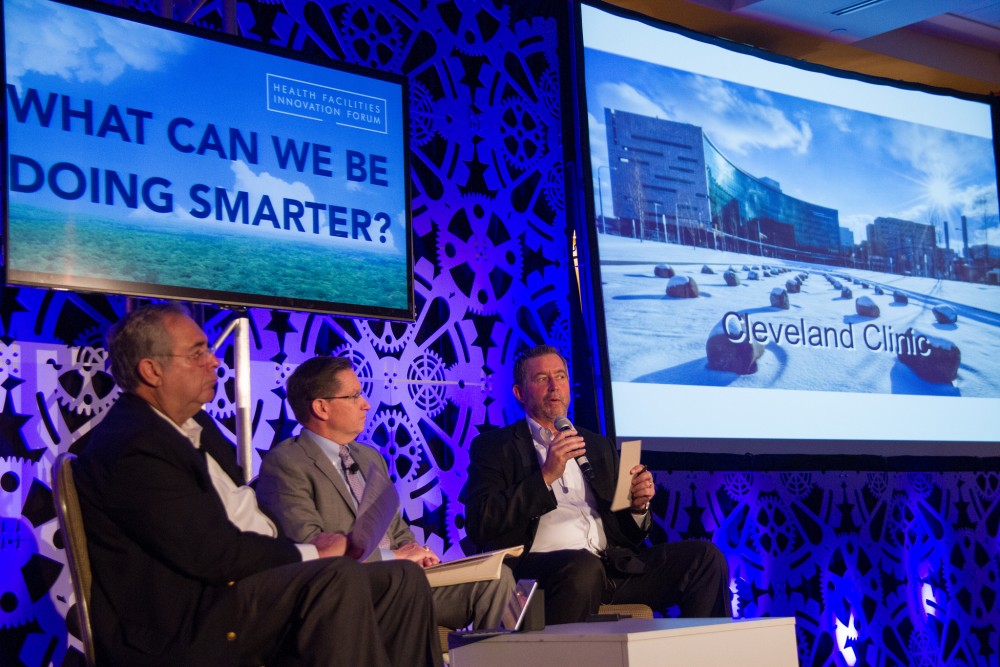The days of doctors and medical facilities calling all the shots are coming to a close and will be replaced by same-day appointments, flexible hours and providers in new locations, an expert panel believes.
In the near future, patients will be making the rules for healthcare service, forcing providers to offer flexible hours, convenient locations and virtual screening services, among other changes, they agreed.
Scott Mason, Executive Managing Director, Healthcare Group with Cushman & Wakefield, led the high-profile panel, which also included Frank Aucremanne, Executive Director for Real Estate, Planning, Design, Construction & Operations at the Cleveland Clinic, and Sanford Smith, Sr. Vice President, Real Estate and Facilities with Hoag Hospital.
Community health, telemedicine, tighter budgets and “retail medicine” are all in the cards.
Key Lessons from Retail
Mason, a healthcare veteran, posed a key question: “What can we be doing smarter?” From his perspective, three things:
- Everything must shift away from hospital-centric care to “community-based ambulatory care.”
- The patient experience needs to change, with providers serving patients at times that are convenient for them, and
- Retail principles need to be applied to the healthcare industry.
“I have not been disappointed in those beliefs,” stresses Mason, who adds that “disruptive innovation” is essential to progress. “The new way of approaching things is to lower the cost and to do what is demanded by the consumer,” he says.
“There are all kinds of innovations that can lower the cost of healthcare.”
Learning from the Automotive Dinosaurs
According to Hoag’s Smith, the healthcare industry needs to respond to consumer demand quickly. Hoag owns three hospitals in the Newport Beach area of California and is part of the St. Joseph’s healthcare system.
“We’ve got to figure out how to take 50% out of the cost of healthcare,” he says, adding his company could become the “Oldsmobile (the GM brand that went from #1 in the 1970s to defunct in 2004) of the healthcare industry” if it doesn’t learn to “engage in behavior consumers want.”
Smith understands his auto industry analogy; he worked for Toyota for many years before moving into the healthcare industry.
“At Toyota we learned how to create segment brands (Lexus, Scion) and we now need to do the same for healthcare.“

Meeting Millennial Needs
Smith continues: “We’re really good at figuring out how to deliver care to 80-year-olds, but we’re totally missing the fact that a lot of the infrastructure we’re building is designed for us (Baby Boom Generation Americans),” he says. “How do we connect to the next generation – Generation X, the Millennials and Centennials?”
Adapting quickly is essential because “The Centennials are having all the babies now.” And, as deductibles grow, patients will begin shopping for healthcare like savvy consumers. “They’re going to start demanding things that are totally oblivious to us in the healthcare industry.
Blood Pressure & Botox On-the-Go
And affluent Orange County is an especially competitive market, Smith adds. “We’re positioning ourselves for a future that’s less and less certain.”
The region is growing rapidly, with thousands of high-density apartment units going up. Hoag is partnering with some of these residential buildings by installing healthcare and wellness centers on-site.
“We took over one of their old leasing offices and put in a little ‘wellness corner,’” says Smith. “It has a little clinic piece in it so you can get same-day appointments and walk-in. We can do massage therapy. You can even do Botox,” says Smith. “And then we brought in a fitness partner to manage all the fitness programs in the apartment complex.”
It’s a great idea that needs tweaking, he adds. “The goal there is to try to engage with people before they are sick so that we have a relationship with them. Honestly, it hasn’t been the runaway success we expected because we’re open 8 to 6 and the people are at work from 8 to 6.”
The next step is for Hoag and the rest of the healthcare industry to adjust their hours to those “that people expect,” similar to those offered by supermarkets, which are open at night, when customers aren’t working. “We haven’t quite figured that out.”
Treatment on the Spot
Hoag’s efforts to bring medical care directly to its market have extended to creating corporate wellness centers in multi-building/multi-tenant office parks.
This means that people can come to work when they’re not feeling well and see someone in the building quickly. "We can do all kinds of services besides just flu shots,” Smith says. These in-house corporate clinics also give Hoag’s leadership the opportunity to talk to employers about managing their employee population health. "Wellness initiatives benefit patients and providers’ bottom lines".
“I can build a lot of 1,000 sq. ft. clinics for the price of a hospital bed.”
Acting as a Unit
A Navy retiree, Aucremanne supervises real estate, design and construction for the historic Cleveland Clinic, which was founded in 1921 by battle-tested World War I veterans. The Cleveland Clinic still follows the guidelines set by its original team of doctors (authors of the book Act as a Unit), who believed cohesive teamwork between doctors, nurses and other hospital staff led to top-notch care.
His medical facilities continue to thrive by sticking to the principles of teamwork and putting patients first. He sees two trends happening now and in the near future:
- Same-day Appointments. Cleveland Clinic now does over a million a year. “It may not be exactly in your neighborhood, but if you want it today, I can find you somewhere in the city.”
- Shared Appointments, which put a number of people with the same medical issue in the room with one doctor at the same time. This will be common practice in a few years, he believes.
Heightened customer service and technology are the future of healthcare, Aucremanne says. Several years ago, the Cleveland Clinic began addressing patient experience and its staff now includes both a “Chief Experience Officer” and “Chief Innovation Officer.” The clinic has studied the experience of its patients and their families carefully, beginning with the parking lot and reception areas. “Patient experience is a huge issue, (because) one bad experience will be relayed to at least 10 people,” he says.
Technology-Driven Hospitals
The clinic has been such a leader in using advanced technology that “IBM Watson is going to medical school at our clinic.”
It has even installed electronic cameras throughout its ICU rooms. “Our Director of Clinical Engineering realized how exposed our ICUs are” which prompted the clinic to add electronic cameras throughout its ICU rooms. With EICU cameras in the rooms, a small overnight team can monitor the ICU patients remotely. Lets five people monitor several hospitals across their system.
“This is an innovation we’re looking to export,” Aucremanne adds. “It standardizes care and offers an upgrade in quality as well.”
Retail Medicine—the Future is Now
Skype-based medicine is on the near horizon, says Smith. “Telehealth will be one of the fastest growing aspects of healthcare over the next decade or so,” he says, adding that this option will improve care in rural communities.
“There’s already lots of venture capital in remote healthcare options. The infrastructure exists to deliver it and it will be affordable to do.”
According to Mason, Retail medicine works for patients and, financially, for providers. Healthcare facilities are being added to existing shopping centers, and these providers are largely “nurse-driven.” “Patients really like retail medicine,” which they often access when they’re visiting a retail chain like Walgreens for different reasons.
“There’s no reason to take your child with an earache to an emergency room and pay $500.”
You can check out video of the full discussion from the 2015 Health Facilities Innovation Forum below.
Posted by
Collaborate with your Peers!
HealthSpaces is a community for people that plan, design, build and operate spaces where healthcare is delivered.
June 7-9, 2026 | Braselton, GA
Learn More




-4.png)
-Dec-09-2025-05-48-44-4379-PM.png)
-4.png)
-1.png)
-2.png)

Comments